Research
Centre for Climate Robust Electronics Design (CRED), a novel research initiative under the Centre for Electronic Corrosion (CELCORR), is dedicated to addressing the corrosion reliability and robustness requirements of electronics. The project places a particular emphasis on high voltage/power electronics as they are increasingly used in renewable energy systems and electrification, among others. Additionally, the project will investigate the impact of exposure to gaseous conditions in conjunction with humidity.
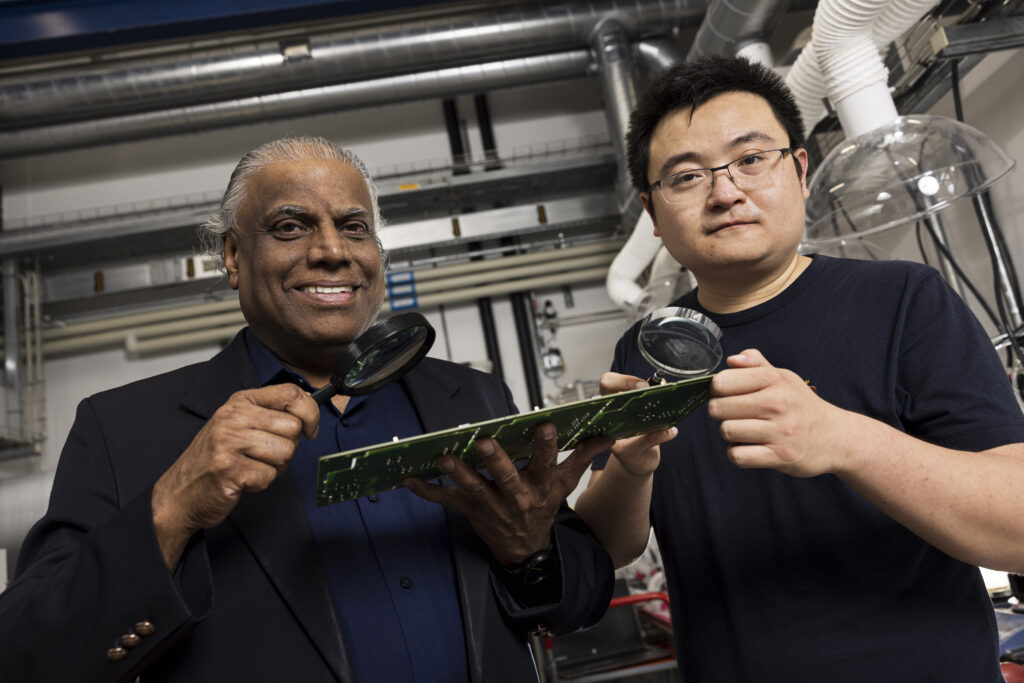
Dr. Rajan Ambat (left) and Feng Li, Department of Mechanical Engineering Technical University of Denmark. Photo: Joachim Rode
During the duration of the project, CELCORR will enhance its laboratory facilities, incorporating the ability to conduct experiments ranging from low to high voltage/current. The objective is to devise measures for corrosion robustness, leveraging the expertise in the research group in materials and corrosion. The focus will be on various aspects including materials, Printed Circuit Board Assembly (PCBA) design and processes, and metal-polymer interfaces in electronics components and devices, and how more robust parts can be made to prevent functional issues due to corrosion by robust design.
“CELCORR’s unique strength is materials and corrosion expertise, and we are applying this to develop environmentally robust designs by understanding design elements that are causing failures and elucidating mechanisms. The CRED project will greatly enhance this capability. In this project, we will also proactively collaborate with relevant stakeholders to ensure that whatever we develop is at the cutting-edge level and applicable to industry needs.“
Professor Rajan Ambat, DTU Construct
The research will also concentrate on understanding failure mechanisms due to high voltage/power effects under humidity and other environmental factors such as gases. It will explore factors that could be manipulated to enhance intrinsic robustness. New laboratory facilities will be established for testing under humid and gaseous conditions, such as H2S and SO2, and for high voltage testing.
- Dive into DTU’s publication Dynamo to learn more about the research group (in Danish)
Project partners:
For more information, contact Rajan Ambat
Artificial intelligence (AI) has become a major part of the societal debate, and the development of AI technologies has brought with it a number of new opportunities and dilemmas. Researchers at Aalborg University (AAU) will examine this across disciplines in a new, large-scale, four-year research project supported by the Grundfos Foundation with DKK 24 million.
“There is plenty of value-creating potential in AI, but we also risk harming our democratic conversation, human rights and privacy when we use it. As business owners, we therefore feel called to help develop responsible practices around the use of the technologies. So we are delighted to be able to support this project.“
Kim Nøhr Skibsted, Executive Director, Grundfos Foundation
Along with Thomas Ploug, Professor in Data and AI Ethics and Jeppe Agger Nielsen, Professor in Organisation and Management at the Faculty of Social Sciences and Humanities, AAU, Thomas B. Moeslund will be part of the joint project management to ensure the interdisciplinary aspect of the research project.
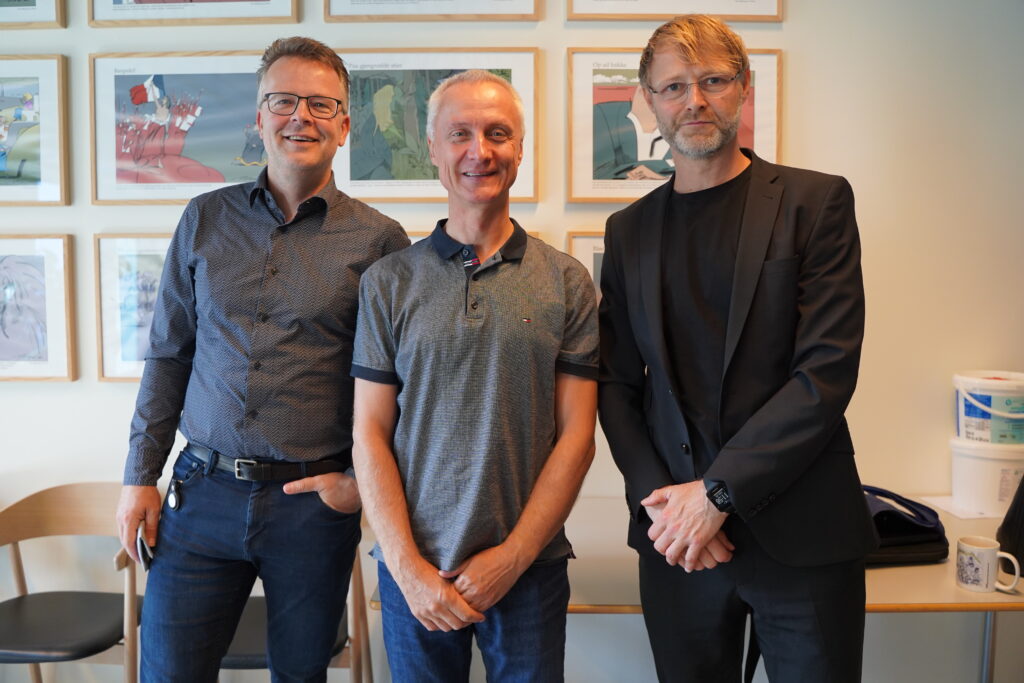
The project is led by AAU researchers Jeppe Agger, Thomas B. Moeslund, and Thomas Ploug. Photo: Anne-Sophia Lundgaard Jensen, AAU Kommunikation
The project is driven by a strong desire to contribute to the major work of developing legislation and policies in the AI area. The project therefore also emphasizes exchange with and communication to a wide range of stakeholders from politicians to the business community. To ensure high quality communication, the project is partnering with consulting firm Mandag Morgen.
The subject matter of the research project is large and complex, which requires an interdisciplinary project team representing diverse disciplines. Collaboration across disciplines is not trivial, and therefore the project will also devote particular attention to this with a separate research effort that, in conjunction with two other AI projects, ‘Algorithms, Data and Democracy’ and ‘Pioneer Center for AI’, examines how collaboration in larger AI projects takes place and can be improved.
Facts
- The project stems from the interdisciplinary AAU centre ‘AI for the People’ – but is an independent project.
- The project runs for four years and is supported by the Grundfos Foundation (Poul Due Jensen Foundation) with DKK 24 million.
- Thomas B. Moeslund is affiliated with the Department of Architecture, Design and Media Technology; Thomas Ploug with the Department of Communication and Psychology; and Jeppe Agger Nielsen with the Department of Politics and Society at Aalborg University.
- The project is led by AAU. Project partners are from the University of Copenhagen, Aarhus University, University of Barcelona, University of Manchester and Georgia State University.
RePair develops technologies to remove lake sediment packed with nutrients in a gentle manner and transform the sediment into:
- Clean water which is led back into the lake;
- A concentrated phosphate fertilizer which can be used in food production;
- A biological carbon product for soil improvement.
The process aims to be circular, producing only potential heavy metal leftovers that can be separated and contained safely, away from the natural environment.
“We want to change the existing paradigms in lake restoration and make it possible to include lake restauration and resource recovery in the same process.“
Ole Wolff, Project Manager, RePair
Behind the project are four Danish universities and Dansk Ingeniør Service (DIS, Danish Engineering Service) to develop the process, covering the following elements (illustrated below):
- Gentle extraction of sediment;
- Dehydration of sediment via for instance:
- Flocculation (def.) with bio polymers (avoiding synthetic micro or nano plastic) followed by mechanical or electro osmotic dehydration;
- Hydrothermic dehydration and carbonization (HTC) of sediment to increasethe amount of dry matter and thus the potential soil improvement;
- Extraction of phosphorus (P) and nitrogen (N) from the residual water through electrochemical processes (electrodialysis and capacitive de-ionization);
- Elektrodialytic cleaning of sediment from phosphorus (P) and potential heavy metals;
- Testing the usefulness of the various products and their qualities as fertilizers in lab and field research.
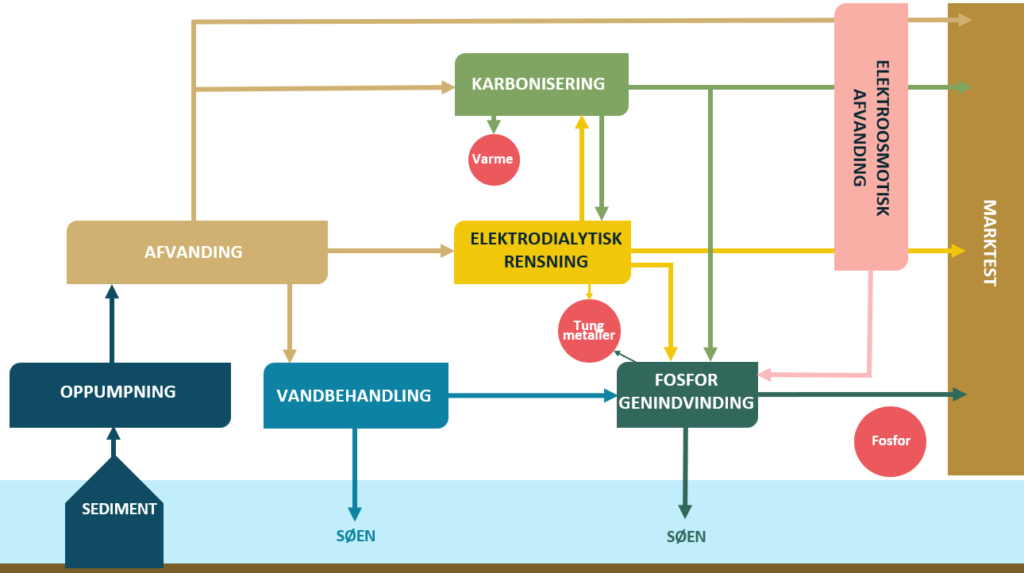
The diagram illustrates the process which cleans up the lake. Sediment is pumped and dehydrated. There are three possible paths for the dry matter 1) further dehydration, 2) carbonization, or elektrodialytical cleaning. Residue water is led back into the lake or further treated before to recover dissolved phosphorus. Illustration: Janne Jørgensen/Grundfos Foundation
Lake Ormstrup is our model lake, but the aim of the project is to provide results and experience to expand resource recovery to many more lakes with various degrees of pollution. Besides providing a toolbox for circular lake repair, each individual work package will contribute to the scientific pool of knowledge within soil physics and colloid chemistry, transport of substances and ions in electrical fields, carbonization and the impact of microplastic on plant growth.
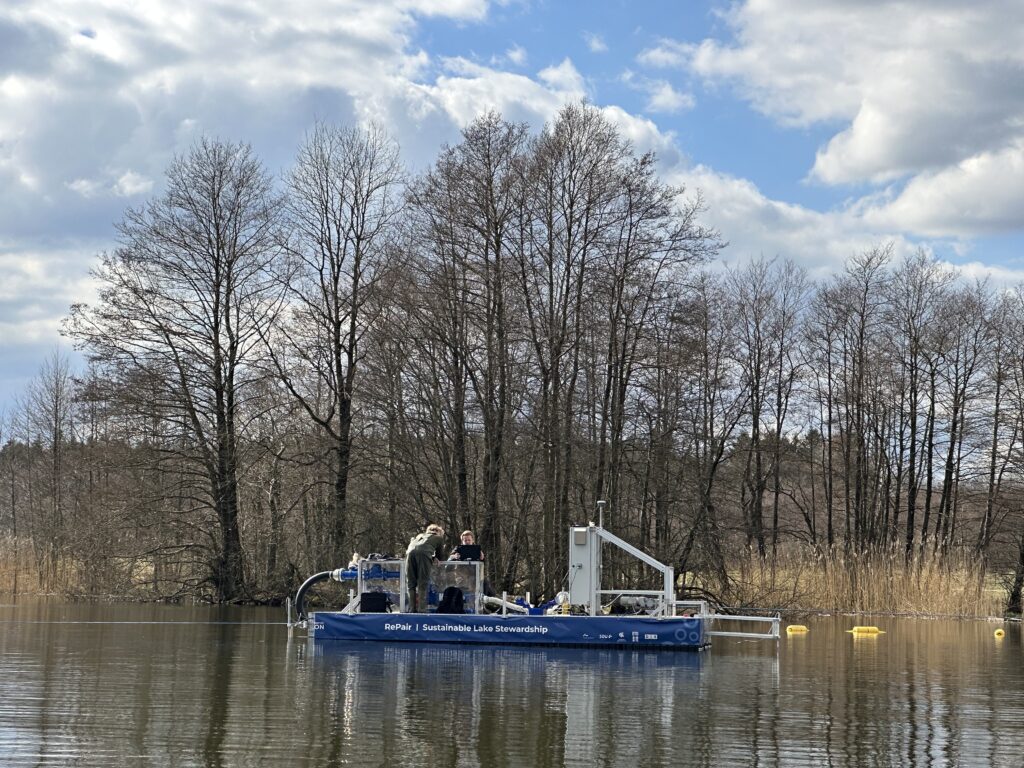
The floating platform removes sediment from the lake which is then dehydrated and tested for various purposes. Photo: Steffen Buck-Hansen, DIS
The scientific contributions will improve the use of advanced technology for lake restoration and hopefully also impact other uses of the individual treatment technologies. In short, we want to change the existing paradigms in lake restoration and make it possible to include lake restauration and resource recovery in the same process.
The project has been defined by the Grundfos Foundation and includes four universities:
The project runs parallel to “Sustainable Lake Stewardship”.
Inter-PBL will contribute to the development of innovative educational models ‒ nationally as well as internationally – with the aim of educating engineers to work proactively and interactively in an interdisciplinary work environment
The project will develop curriculum models for students’ learning of interdisciplinary generic competences in a PBL curriculum based on case studies on 1) new curriculum practices in interdisciplinary projects where the students are working on sustainability problems across educational programs, 2) interdisciplinary projects in companies, and 3) transdisciplinary projects with universities and companies working on common problems.
“Inter-PBL will develop models for students’ learning of interdisciplinary generic competences in a PBL curriculum based on case studies at Grundfos, The port of Aalborg and Aalborg University. Inter-PBL thereby contributes with new knowledge on interdisciplinary collaboration and learning to overcome boundaries in education as well as companies.“
The project is run by Professor Anette Kolmos, Associate Professor Jette Holgaard, and PhD students Henrik Worm Routhe and Maiken Winther.
The goal is to develop:
- Theory, methods, and tools for collaboration processes in a variety of interdisciplinary projects in education, with inspiration from good practices in companies;
- Theory, methods, and tools on the learning of PBL competences in interdisciplinary projects and the learning of meta-competences for transfer of learning;
- Curriculum models for enhancing the quality of existing PBL models addressing interdisciplinarity, and for international and national inspiration.
“In order to participate in professional interdisciplinary work, it is important that students have experienced the work processes in educational interdisciplinary projects. Further, reflection on the practice experiences will facilitate the students’ learning and the transformation of interdisciplinary competences.“
Professor Anette Kolmos
Inter-PBL contributes with new knowledge on interdisciplinary collaboration in student teams and in companies based on analyses of cases in both education and in companies. Inter-PBL also contributes with new knowledge on how meta-reflection may be essential for the development of generic PBL competences. The meta-competences are necessary in order to participate in complex and interdisciplinary project processes in companies and education. Finally, Inter-PBL will develop curriculum models to achieve these competences.
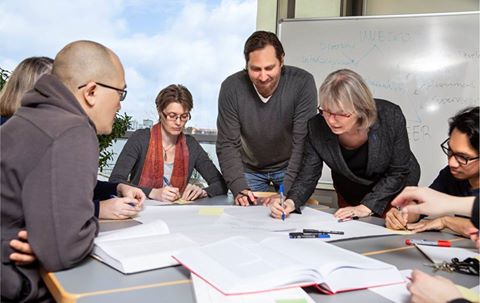
Anette Kolmos and colleagues at work. Photo: Aalborg University
A range of different technologies and materials (such as new wide band gap semiconductors) lower the barriers of green solutions replacing fossil fuels within the energy and transport sectors. Increased usage of electric vehicles, controlled pumps, hydrogen electrolysis and wind turbines demands higher performance of power electronics: They are the ‘glue’ connecting electric ‘functional blocks’ together and allowing energy to flow from producer to user.
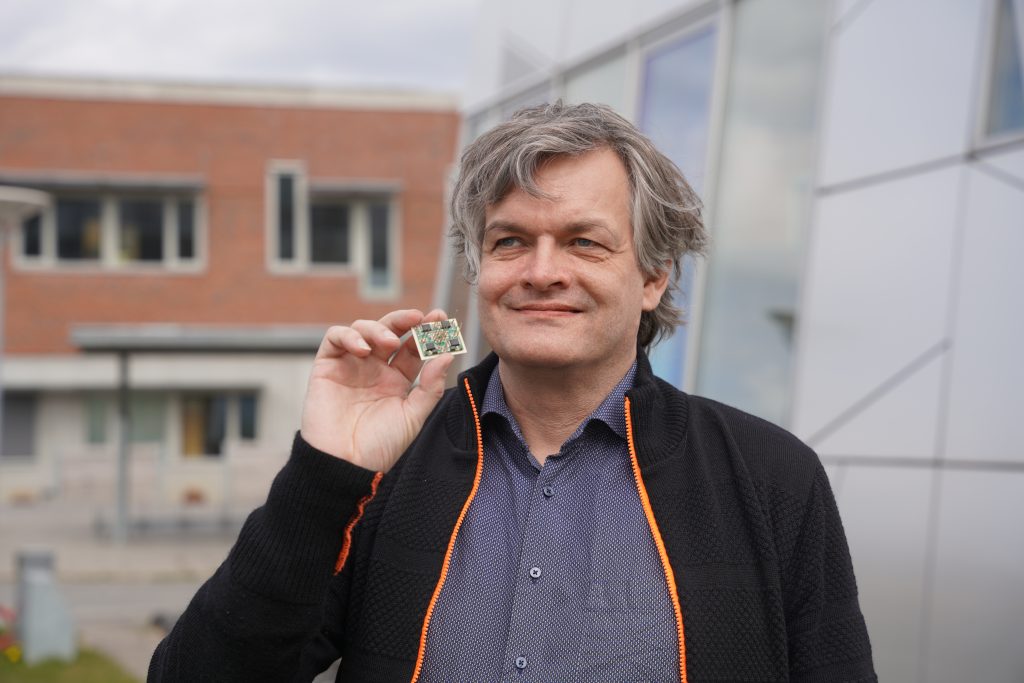
Center of Digitalized Electronics (CoDE) is led by Professor Stig Munk-Nielsen, AAU. Photo: Hongbo Zhao, AAU.
Industry needs new solutions
Center of Digitalized Electronics (CoDE) at Aalborg University ‘s Department of Energy Technology will develop methods and push the boundaries of digital design and product qualification processes allowing for higher efficiency and more compact power electronics systems. The project springs from a long collaboration with Grundfos’ engineering department, but with the backing of the Foundation the researchers want to make more efficient digital design processes more widely available to the industry.
“Our goal is to transform the design process from several physical prototypes in the laboratory into more and faster design-iterations on a digital platform. The vision is that only a single physical prototype has to be manufactured to achieve the specified performance.“
Professor Stig Munk-Nielsen, Aalborg University
The goal is to rethink the traditional design approach based on laboratory experiments. The process is resource-demanding, and design round-trip loops can last many weeks; experience with digitizing parts of the design process is very promising. In the CoDE project, our goal is to increase the digitalization level of today’s development process to include electrical, magnetic and mechanical domain.
CoDE research group
Key members of the research group are: Associate Professor Christian Uhrenfeldt, Postdoc Asger Bjørn Jørgensen, and Professor Stig Munk-Nielsen,
5 PhDs and 2 Postdocs will be added to the team over the next five years.
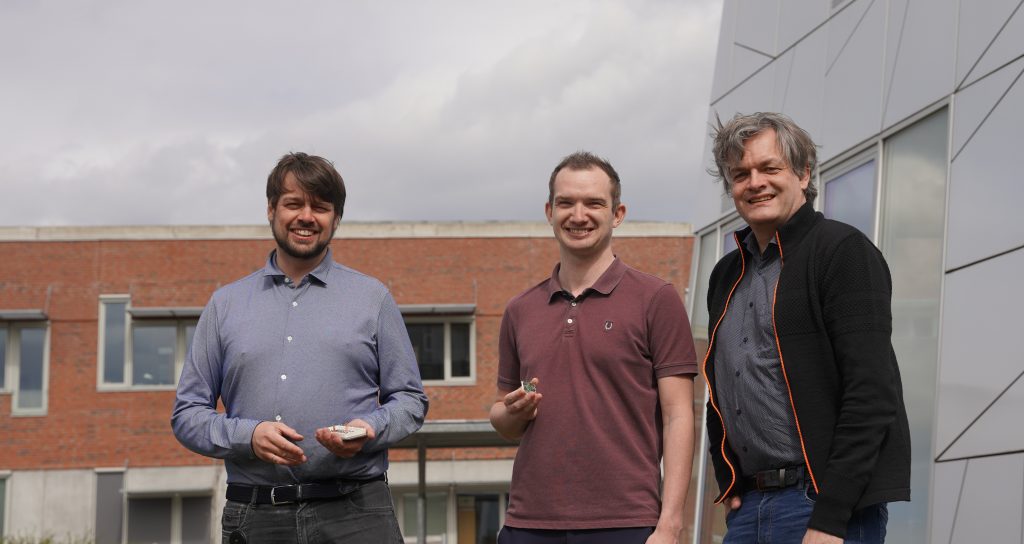
From left: Associate Professor Christian Uhrenfeldt, Postdoc Asger Bjørn Jørgensen, and Professor Stig Munk-Nielsen. Photo: Hongbo Zhao, AAU
Next Generation Water Action is a global initiative that engages 100+ young talents from leading international universities and early stage start-ups, representing the next generation of water leaders. Coming from Ghana, Kenya, Mexico, South Korea, India, and Denmark, the Next Generation’s Water Action Ambassadors combine their diverse backgrounds and skills to foster a global answer to the world’s most pressing sustainable water challenges.
“Highly diverse in backgrounds yet united in their mission of challenging the status-quo of the global water industry, 11 startups and 22 selected student teams from universities in Kenya, Ghana, South Korea, Mexico, India and Denmark combine forces to crack some of the world's most pressing water challenges petitioned by our international partners.“
Together with Poul Due Jensen Foundation, Grundfos, Rambøll Water & Foundation, the International Water Association (IWA) & IWA’s Young Water Professional network, the Innovation Centre in India & Seoul, the Embassy in Ghana and global challenge partners, DTU Skylab & DTU Environment bring forward a tailored virtual program, that goes beyond the attendance of youth in events, but enables them to take action together with the corporate world and academic & public partners. The participants will not only be supported with mentorship, industry insights and bootcamps, but will also get a relevant stage to showcase and discuss their bold ideas with global decision makers.
“We felt empowered and focused on our duty to save our world. I think that the important thing is to support young people, since we are the ones who in a few years will be making the decisions “
Former Next Generation Participant from Colombia
Facing the current COVID-19 crisis, redesigned from previous successful Next Generation initiatives, Next Generation 2021 goes virtual for the first time in its history – being even more inclusive, scalable and sustainable than ever before: More participant spots, a global network of water professionals that provide sparring across time zones, virtual events, keynotes, and bootcamps, with less emissions as a great side-effect.
Timeline
The program runs from February. 2021 – May 2021 (Involving students in the spring semester 2021)
- February to April: Kick-off and Solution Development Phase with Bootcamps, Mentor Session and Keynotes
- 18th of May: Global Multi-Hub Final with local live events in each participating country
- June: Acceleration of selected student and start-up teams
- September 2022: Involvement of selected teams in IWA World Water Congress
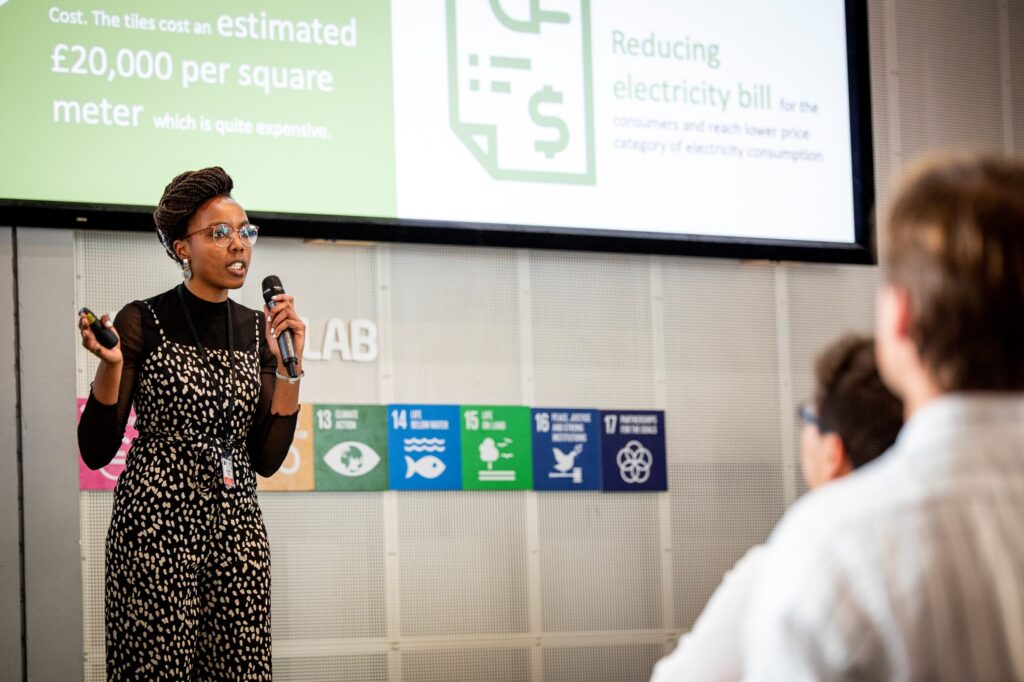
Young participant speaking at conference. Photo: DTU Skylab.
Lakes all over the world are in a miserable state. Two thirds of Danish lakes do not live up to EU minimum standards regarding the aquatic environment. The reason is decennials of neglect in the shape of wastewater and washed-out nutrients from intensive farming. A ‘green’ lake emits twice as many greenhouse gases as a clear lake, and put together, lakes all over the world visibly impact the climate.
On the other hand, phosphorus is a precious resource: Phosphorus is mined in China, Russia, USA and Morocco, but when the mines are emptied in a generation or two, we will need to find our phosphorous somewhere else in order to provide fertilizer for our crops. There is no alternative to phosphorus.
“Lakes all over the world are in a miserable state. The problem is too many nutrients, phosphorus in particular, but also heavy metals. Together with Danish researchers from several universities, we've set out to fix the problem“
Poul Toft Frederiksen, Programme Manager, Research
In the first phase of the project, Lake Ormstrup has been selected as the test object. Both the environment and the animals in and around the lake have been rigorously mapped and characterized in 2020, and the researchers will follow the development over the next years as they set out to develop and test new lake restoration methods and technologies.
We want to know where the phosphorus is stored and in which form; the history of the lake; how much sediment can be removed; can it be used as fertiliser; how do the fish respond to the interventions; and what are the socio-economical consequences of the activities.
A gentle extraction method
Standard lake restoration techniques are digging out the sediment or adding aluminium to bind phosphorus, but both are very brutal interventions, and neither are guaranteed to last. The researchers want to find a new method to extract the harmful phosphorus from the lake and transfer it to a place where it is useful. They look into whether the sediment can be used directly as fertilizer in farming, or if it is bound in chemical compounds that prevent crops from extracting the nutrients.
The consortium will welcome research colleagues from more Danish universities in the next phase of the project that can help develop and test the methods.
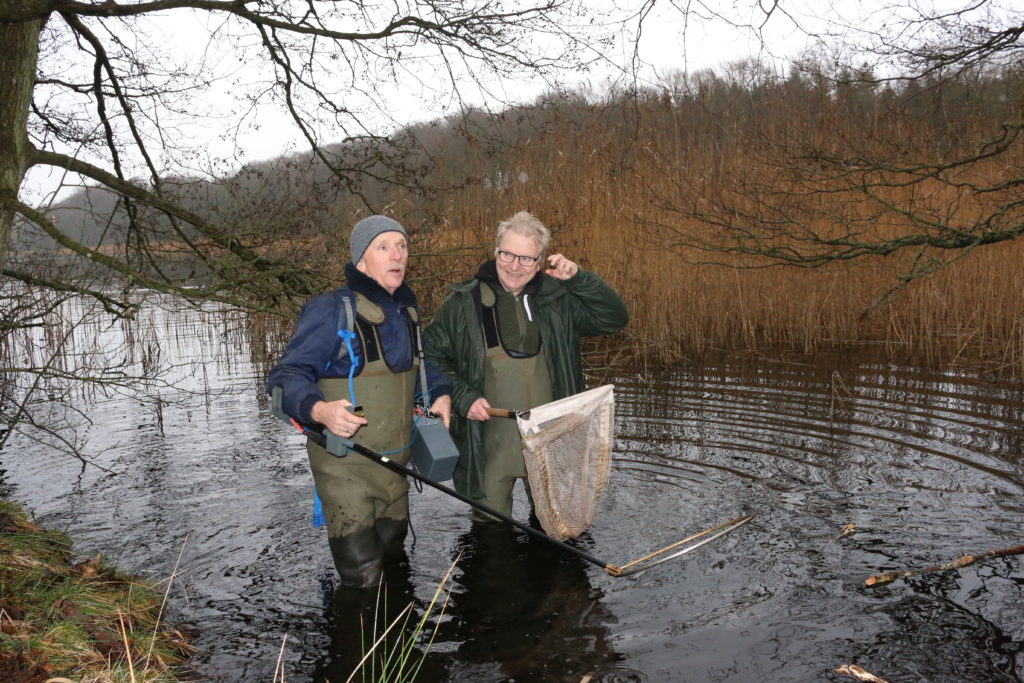
DTU’s engagement i forprojektet ledes af lektor Christian Skov fra DTU Aqua (højre), her i selskab med kollegaen Jes Dolby. Foto: Poul Due Jensens Fond
Several universities onboard
Four universities are part of the project as per 1 January 2021:
This flagship project is a sister runs parallel to “Circular Phosphorus Recovery (RePair)”.
Turbulence is created when gas, e.g. air, or liquid moves sufficiently fast. The speed of the fluid motion does however not necessarily have to be that high. As an example, it is almost unavoidable to generate turbulent fluid motion when pouring cream into coffee. The general principles are easily described and the equations have been known for almost 200 years. However, the details of the mathematical problems are so complicated that solving the equations describing turbulence has been named one of seven great mathematical problems of the 21st century. The physicist Robert Feynman has named turbulence as the most important unsolved problem of classical physics research.
The models which are used in designing pumps, windmills and other machines that move in turbulent environments are based on approximations and have limited application areas. A widely used approximation for ‘very turbulent flow’ was published in 1941 and the assumptions behind have almost reached a status of physical law.
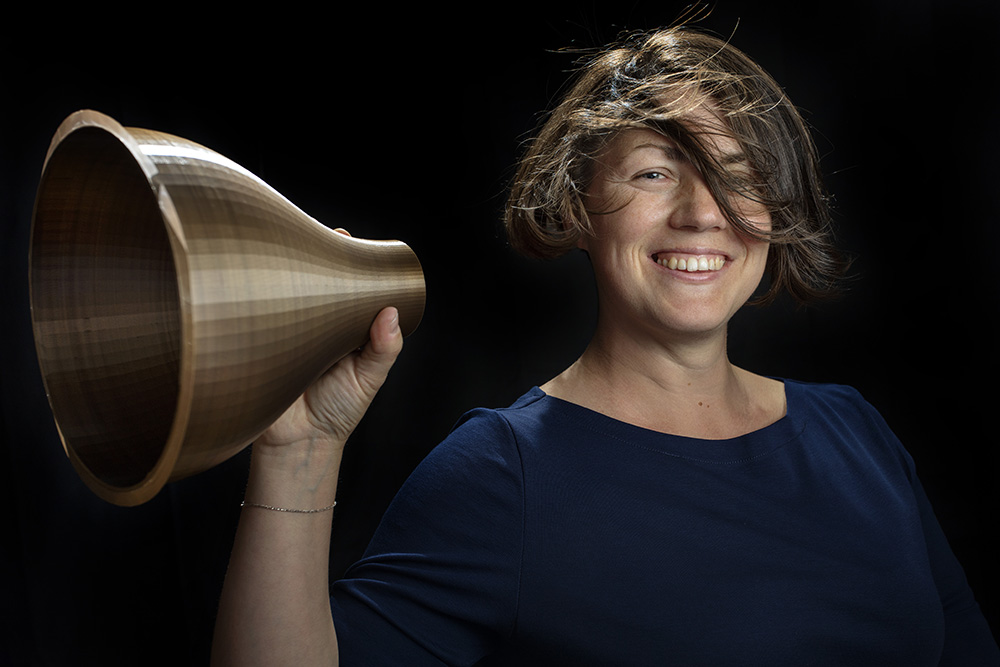
Associate Professor Clara Marika Velte, DTU Mechanical Engineering.
Old assumptions don’t hold water
New experimental and theoretical research from, among others, Clara Marika Velte at DTU Mechanics, has shown that there is a need to reformulate the equations and she has therefore received an ERC Starting Grant to document how the assumptions are mistaken. Parallel to this work, the Poul Due Jensen Foundation funds work on re-formulating the mathematical models and to communicate the results internationally.
“The main objective is to develop novel, robust, theory based on a combination of advanced experiments and mathematical analysis. To be able to describe turbulence using mathematics, the concept of waves is applied and coupled back to the governing equations of fluid motion.“
Clara M. Velte, Associate Professor, DTU
Project purpose and design
The project aims to contribute to a more robust theoretical framework for understanding turbulence. We want to ensure that the results are shared with industrial stakeholders and international peers and help develop an internationally recognised centre of excellence.
- The lab facilities will be established at top international level to attract international talent and collaboration
- Relevant industry representatives will be invited to follow the work of the research group
- As of 2021, a bi-annual international summer school programme will be offered
The grant of DKK 12.9M runs from 2019 to 2023.
The number one problem with boreholes is that you usually do not know if you will find water until you’ve drilled a massive hole in the ground. Another problem in coastal areas is over-pumping, which over time draws salt water into the groundwater reservoirs and destroys the drinking water supply. Both problems are global and critical in developing countries because of combined population growth and climate change.
- The HydroGeographics research group at Aarhus University GeoScience have developed a lightweight tTEM tool to map the underground in three dimensions and in great detail. You can find out more about the technology and its potential here: Meet the researchers.
- In 2021, the Foundation granted 2.2 mDKK to develop SuperTEM. This project stands on the shoulders of the results from our previous engagements. Find out more about the project here.
“The device sends out an electromagnetic pulse and measures the response with a receiver. With the data, we can map the conductivity of the underground and determine not just if there is water, but also whether the water is fresh or saline.“
Professor Esben Auken, Aarhus University
Previously, the device has been used hanging from a helicopter in the US, Europe, and even in Antarctica. In Denmark, a more ‘grounded’ version is used which is pulled by an ATV. It can map up to 100 hectares (247 acres) in one day.
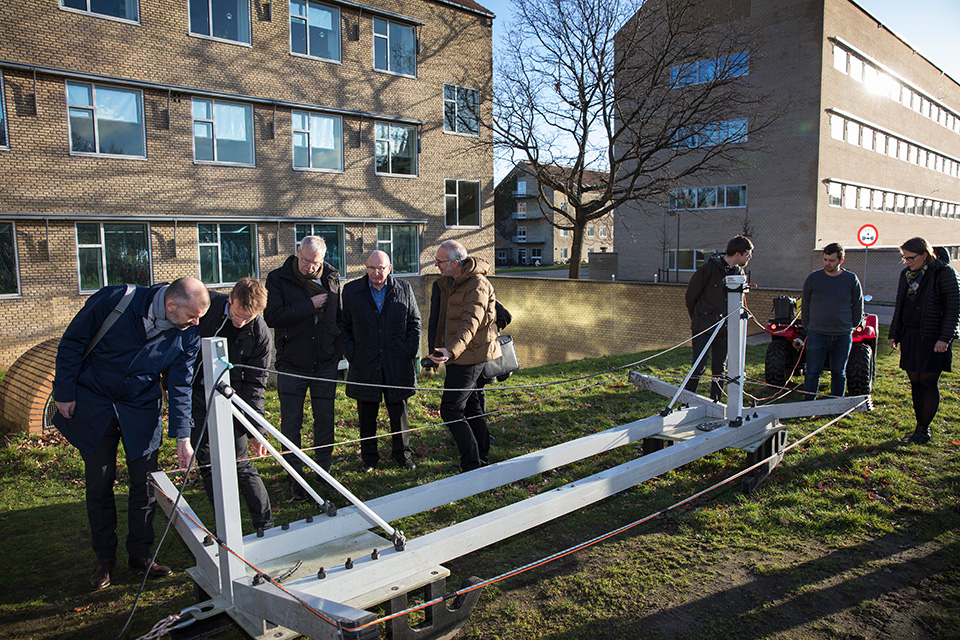
Professor Esben Auken et.al. showing the device to Niels Due Jensen, Kim Nøhr Skibsted and Poul Toft Frederiksen. Photo: Søren Kjeldgaard/AU
Killing two birds with one stone
There are two goals with the reseach project:
- To develop and demonstrate the technical and business potential for detection of underground water reservoir in Africa through two test campaigns in WesternTanzania,
- To develop making the device usable by non-geologists. This is a prerequisite for rolling out the technology in large scale.
We hope the project can demonstrate remarkably improved possibilities for sustainable water supply management and that it will contribute to developing new methos to monitoring saltwater intrusion in coastal areas.
Tests in Tanzania
The new device will be tested twice in collaboration with the Foundation’s water partner, Water Mission. The technology has already, in a more primitive version, been used in the Foundation’s Nyarugusu water project in Western Tanzania by one of Esben Auken’s research fellows (Dr. John Lane, US Geological Survey, who will participate in the project). The device helped identfy the area’s largest groundwater source in 2017.
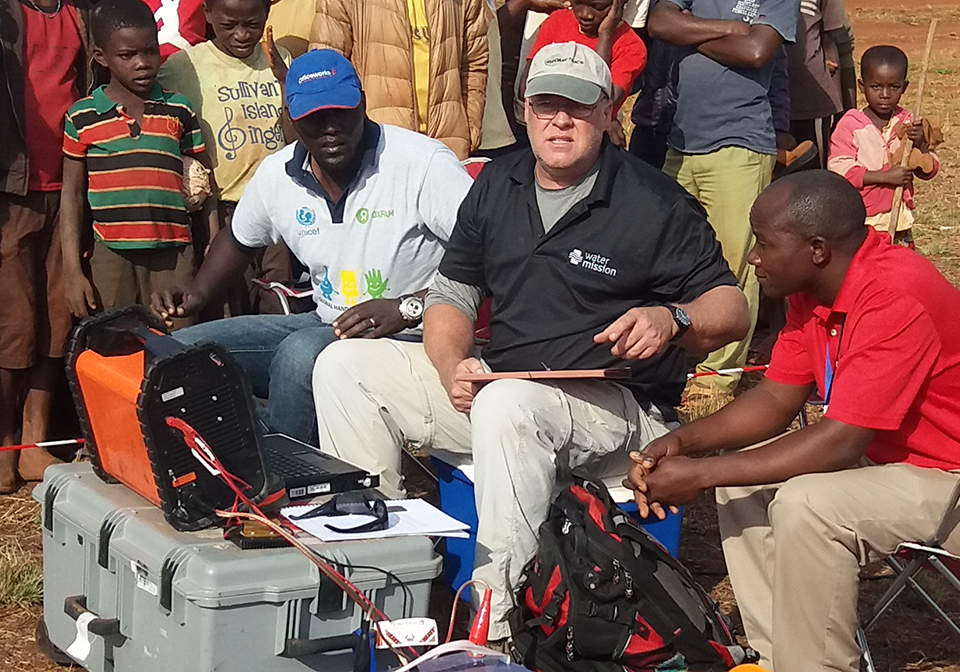
Dr. John Lane, USGS, tested the technology in Nyarugusu Refugee Camp in 2017. Photo: Water Mission
If successful, the project supports two of the Foundations philantropic programmes (Research and Water), contributes to achieving UN Sustainable Development Goal 6 and could in time lead to interesting business opportunities for Grundfos and its partners.
“It is crucial for the Foundation's water projects in communities and refugee camps that we can find water underground. Recently, we drilled 6 times in a small community and did not find water. The cost was about 10,000 EUR, add to that the risk of accidents or contamination of the groundwater reservoir if the borehole isn't sealed properly.“
Nils Thorup, Programme Manager for Water, Poul Due Jensen Foundation
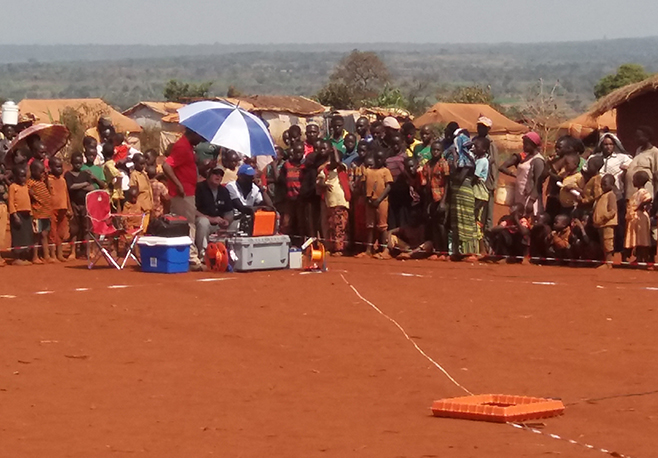
The largest water source in Nyarugusu Refugee Camp with a yield of more than 99 m3/h was identified by Dr. John Lane in 2017. Photo: Water Mission
The overall goal of the Aarhus University Centre for Digital Twins is to understand how to leverage existing engineering multi-models for the construction of digital twins. This entails improving state-of-the-art in co-simulation algorithms, understanding which multi-models are adequate for digital twin construction, and what kind of faults can be detected/diagnosed.
Attaining this goal implies tackling traditional tradeoffs, such as how detailed we need the co-simulation predicting the behaviour of the digital twin to be, versus how fast? But also new challenges, such as when can one declare that there is a mismatch between the observed behaviour of the original twin, and the simulated behaviour of the digital twin? Can we trust the co-simulation results enough to declare that the original system is faulty when there is a mismatch? What kind of decision support can be provided in analysing the consequences of alternative interventions?
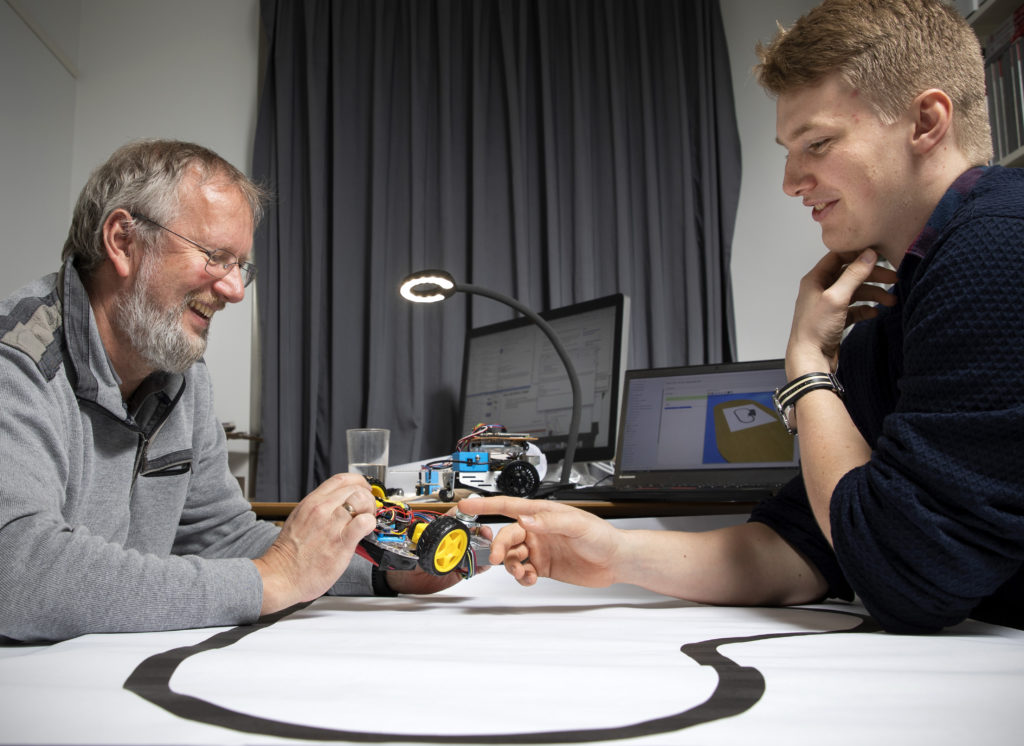
Professor Peter Gorm Larsen and engineering student Christian Legaard with a robot car. The PC in the back shows a digital simulation model. Photo: Aarhus Uni/LK
Industry collaboration
The project is lead by Professor Peter Gorm Larsen, who wants the research to be done in collaboration with relevant companies, both SMEs and larger industry players. He worked in industry for 17 years before becoming a professsor at Aarhus University. Find out more in AU Engineering’s profile magazine (p 34).
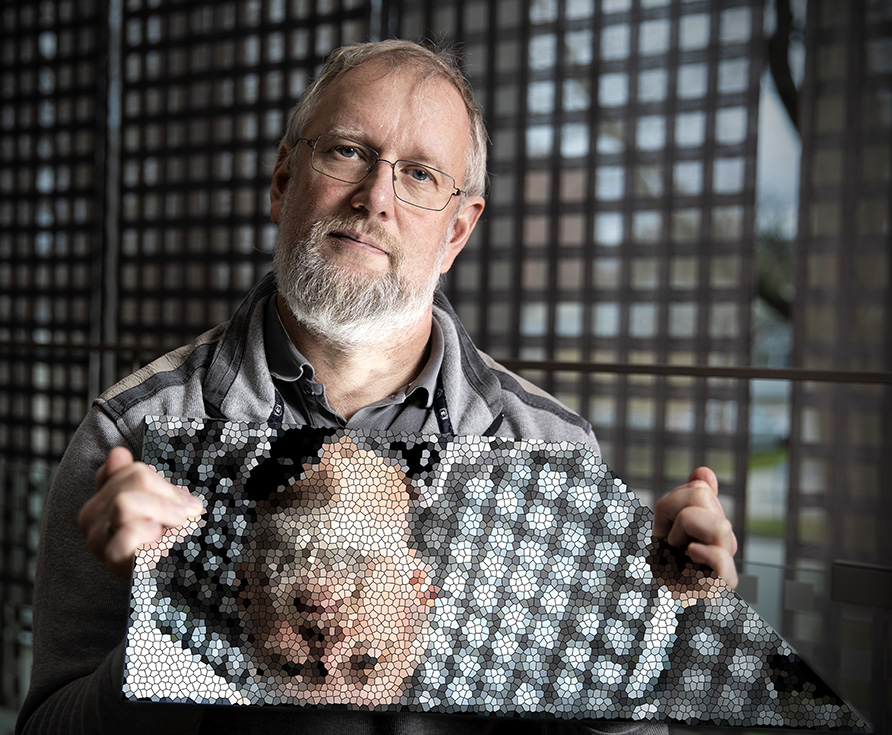
Professor Peter Gorm Larsen. Photo: Aarhus Uni/LK
David Bue Pedersen, who heads up the DTU 3D printing research group, has received a grant for a 5-year research project perfecting the the processes behind 3D printing technologies – especially when it comes to geometric precision and mechanical applications. The project will cover 3D printing with both metal and plastic, more commonly known as additive manufacturing.
“It will be super relevant for Danish industry to have access to knowledge and expertise about how 3D printing can be more widely used in production.“
Kim Nøhr Skibsted, Executive Director
The project will describe physical snd digital systems behind the two most popular industrial 3D printing methods within metal and photo polymer printing via a modularisation of the processes. Afterwards, an open architecture will be created and all documentation behind the architecture (hardware, electronics, source codes will be made publicly available, allowing researchers and industry to drive further development within this field.
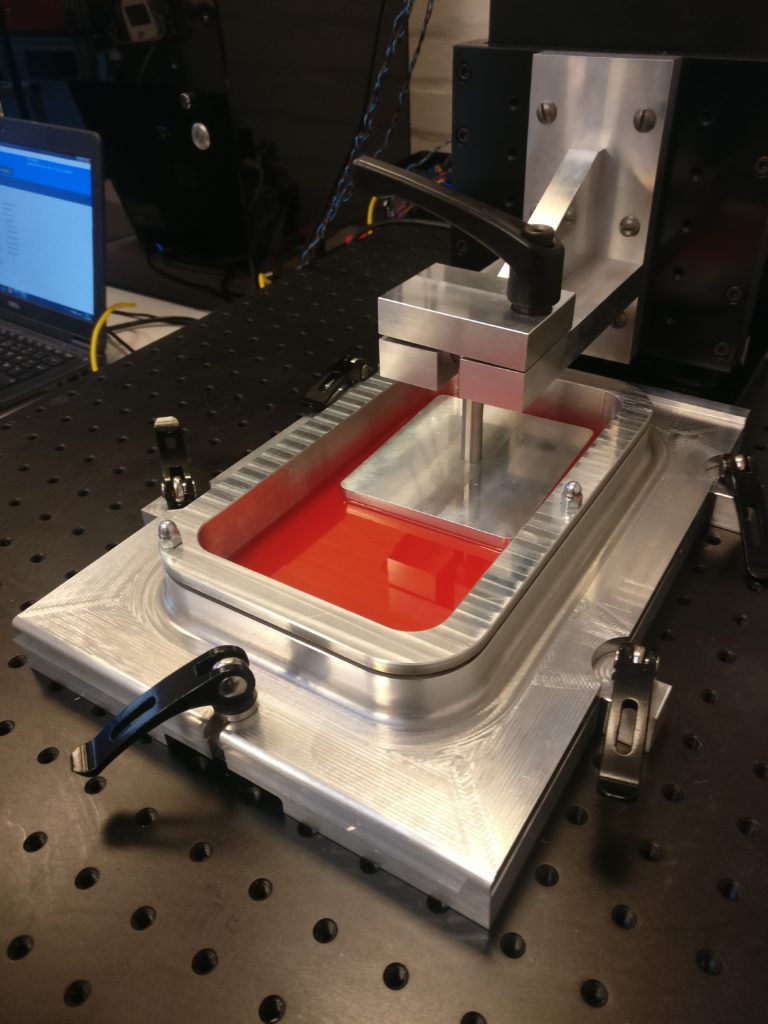
DTU’s photo polymer 3D-printer. Photo: DTU Mechanical Engineering
Research in 3D printing is on the rise, albeit concentrated on design and materials as well as quality assurance.
“You need skills within many disciplines such as construction, physics, chemistry and process technology to develop new processes that are faster, better and more cost efficient.“
David Bue Pedersen, DTU Mechanical Engineering
These skills are all present in the DTU research group and will push existing state-of-the art within 3D-printing.
“We participated in the Science EXPO in April, and the Stockholm Junior Water Prize is in August. In between, we were privileged to visit researchers at DTU Environment who guided us with regards to report structuring and developing our research poster. They also let us use some of their equipment to refine our experiments,” the boys explained when we caught up with them during a short break at the conference centre in Stockholm.
All four participated in a tightly packed special conference programme for Stockholm Junior Water Prize contestants, while only two (Kristian Katholm Nielsen and Sebastian Lykke Dalsgaard) were allowed to present the project to the international jury.
“It was a great experience to present the project to the jury – not at all like an exam. They seemed really interested in our project and asked us questions about how we had thought and developed our project.“
Kristian Katholm Nielsen
Nonetheless, all four had a learning experience for life, enjoying access to both interesting people and new knowledge.
“It was amazing to meet and spend time with the rest of our competitors. We all work on different projects, but in the end our interests are similar, as we all want to contribute to a water safe future,” concludes Rasmus Thoft Nygaard.
Meet the 2019 Stockholm Junior Water Prize participants:
Stockholm Junior Water Prize finalists 2019 from SIWI on Vimeo.
The Department of Computer Science in Aalborg is set out to expand with two new international professors, each with four full-time postdoc positions at their disposal, thanks to a grant from the Poul Due Jensen Foundation. The two professorships will fall under two separate research groups in the department.
Future-proofing and generation shift
The business community is hungry for university graduates in Computer Science, and this looks set to continue for a long time to come. Over the past ten years, the Department of Computer Science has had significant growth in the number of students, and with two new professorships, the university wants to both generally strengthen as well as future-proof the area.
Top researchers head the two research groups that will be home to the two new professorships. The high-profile researchers, Professor Kim Guldstrand Larsen (distributed, embedded and intelligent systems) and Professor Christian Søndergaard Jensen (databases, programming and web), both have long CVs and have achieved many significant results, and they are also the two most cited computer scientists in Denmark. Kim Guldstrand Larsen received the prestigeous Grundfos Prize from the Poul Due Jensen Foundation in 2016.
The digital future
Aalborg University (AAU) has distinguished itself with groundbreaking solutions for effective management and analysis of temporal, spatial, and multidimensional data in relation to e.g. transport and green energy, as well as with efficient and automated validation and optimization of software embedded in products, such as safety critical software in cars and intelligent traffic management systems.
Computer science is a very important area for AAU where they have always been on the forefront. Digitalization will undoubtedly be the biggest technological force for change in society in the coming decade. By strengthening the area, we ensure that AAU continues to deliver usable knowledge and graduates to business and to society.
Facts
The Poul Due Jensen Foundation has granted 17 million kroner, covering both employees up to 2023. AAU then takes over the full financing of the appointments, thus future-proofing the two professorships.
“Inspiring science for teachers and students” is meant as a contribution to creating more exciting science teaching in public schools and secondary education institutions. In the long term, the purpose is to increase the interest of pursuing a career in science and/or technology among young people in Denmark.
The House of Natural Sciences develops and tests learning activities within four main areas:
- Inspiration for teachers and teacher students
- Thematic days and activity days pupils, such as Engineering Day og Girls’ Day in Science
- Development of new teaching tools and thematic teaching kits, which can be integrated directly in the classroom
- Better communication and marketing of the house’s offerings
The Poul Due Jensen Foundation helped build Naturvidenskabernes Hus in Bjerringbro in 2005 through a 15 m DKK donation.
WATEC opened in October 2017 as an interdisciplinary strategic research initiative, bringing together and reinforcing water technology research in a broad sense, from mapping water resources and the natural water cycle to wastewater management and development of sensors to control water purification and identify harmful substances in water.
Through basic research, the centre aims to produce new insight, and utilise this insight to arrive at new and better solutions through applied research within water technologies.
“Research at the centre will address crucial social tasks, while at the same time generating considerable potential for Danish industry – for existing as well as new businesses within the Danish water sector,” said Niels Christian Nielsen, Dean, Science and Technology, Aarhus University.
The four donations from the Poul Due Jensen Foundation will make a direct contribution to strategies at the research centre.
The donations will fund:
- A new professorship and two postdoc positions within water treatment research
- A professorship and two postdoc positions for research and development of water-quality sensors
- Establishment of an advanced sensor laboratory
- Recruitment of two-three postdocs to give WATEC a broad foundation on which new and innovative ideas can thrive across the centre’s subjects and fields of research.
WATEC is headed by Professor Niels Peter Revsbech, who was awarded the Grundfos Prize in 2013 for his development of advanced sensors and his research into the relationship between microorganisms and the natural conditions under which they live. Indeed, to a great extent, WATEC is based on Professor Revsbech’s achievements; both as a researcher and as an inventor.
WATEC Aarhus University Centre for Water Technology

















